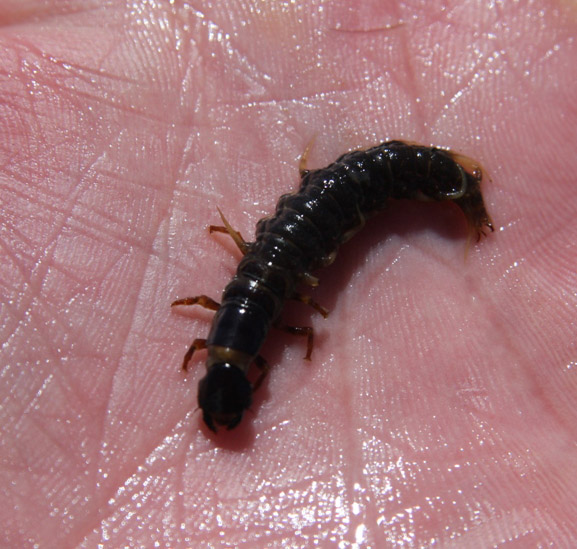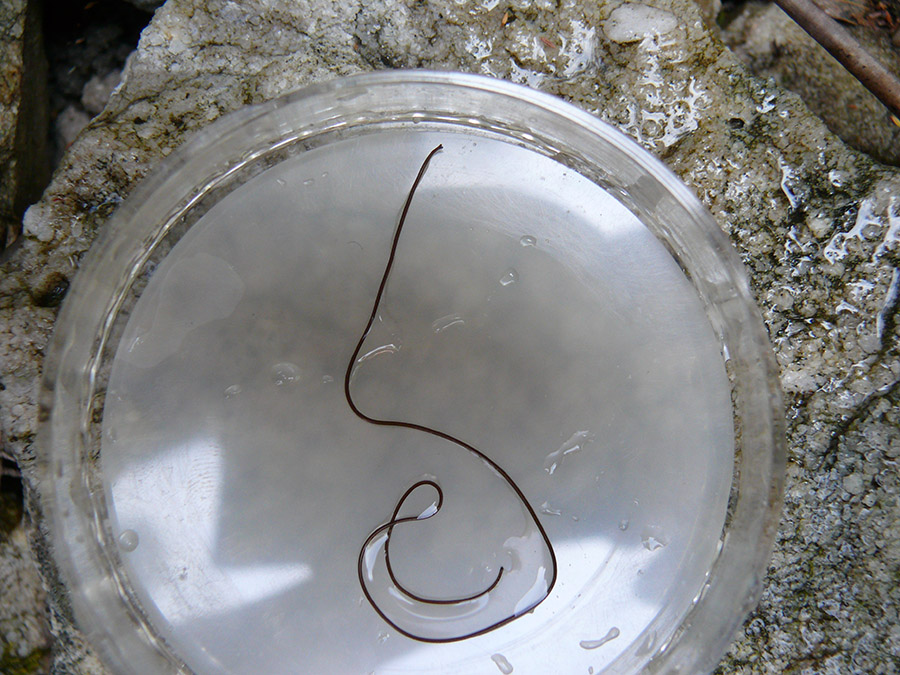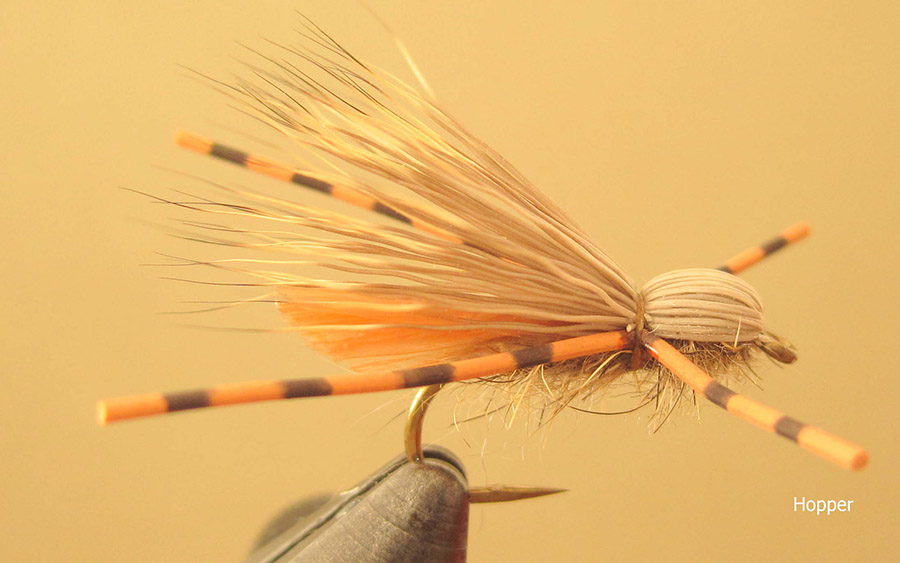The Cape Piscatorial Society plans to place on its website all the scientific studies done over the decades relating to what trout in Africa eat.
Having all the bound copies of its journal Piscator from the first issue published in 1948, I realised that there was a lot of useful information contained in a regular feature called “Notes from the Clubroom Board.” It ran for 14 years from the autumn of 1965 until the autumn of 1979. It was then dropped for space reasons and it was loss which was keenly felt.
Click in images to enlarge them

'Piscator' – an invaluable source of fly fishing information for 67 years
Former secretary, Denise Hills transcribed the most useful information in longhand and it was then typed.
What was clear was that in April and May, the numbers of what we call “Toebiters” – but what are called hellgrammites in the USA - were found in increasing numbers in trout stomachs replacing the Baetis nymphs which are the staple earlier in the year.
At this time the larvae move to the shore, climb out of the water and dig a hole in moist soil where they pupate which makes them very vulnerable to predators like trout. A further interesting factor then became obvious. What is also increasingly found in trout stomach contents in autumn is grasshoppers.
For example on 28 April 1969 one of South Africa’s legendary fly fishing pioneers, the late John Beams, wrote that the trout he had caught on the Smalblaar stream near Cape Town were “Stuffed with toebiters and grasshoppers.”

A Dobsonfly nymph found in the mouth of a 7lb New Zealand brown trout by Rhodes-based guide Fred Steynberg
Quite why this should be so for grasshoppers, though, I was not sure.
Looking for evidence on hopper seasons in the southern hemisphere I found some useful information in Dry Fly Fishing for Trout (Kangaroo Press, 1994). The author, Tasmanian angler Tony Ritchie, says: “Adult insects begin to appear in late December and my records suggest that the fishing they spark usually starts in the middle of January and sometimes extends to the rest of the season late in April. The action seems to peak during the last three weeks of February and the first three weeks of March, perhaps because the grasshoppers are more mature then. With the heat beginning to liven them up, their jumps and flights grow longer and so they find themselves more often on the water.”
Perhaps, I reasoned, they are simply coming to the end of their lifespan in autumn and thus weakening?
I eventually found the answer I was looking for in another Tasmania-related article about the Nobby Hopper, a grasshopper imitation created by the legendary guide, Noel Jetson. It is on the flyanglersonline website and here is the relevant passage: ‘Grasshoppers mate in late summer and autumn, after which the females deposit their eggs in soil. Gradually, as the height of summer looms, less aquatic food is available in lowland rivers and trout start relying more and more on terrestrial foods, particularly grasshoppers.’
http://www.flyanglersonline.com/features/oldflies/part262.php
I found further confirmation in the first really significant book on the subject of land-based insects for fly fishing, Gerald Almy’s ‘Tying and Fishing Terrestrials’ which was published in 1978: “Eggs are deposited in the ground in pods during the fall.”
Mike Picker, one of the co-authors of the Field Guide to Insects of South Africa (Struik 2002), the most user-friendly local book available, suggested another fascinating reason. “Many grasshoppers are parasitized by a worm that makes them drown themselves in water, so that the worm can carry on its life cycle there.” The National Geographic article to which he referred me has some truly hair-raising video footage of this process.
http://news.nationalgeographic.com/news/2005/09/0901_050901_wormparasite.html
But do these worms - called hairworms or Gordian worms - exist in South African streams? They do and I had overlooked a reference to them in Craig Thom’s Stream-X newsletter (which is worth subscribing to) for January 2015.
http://www.streamxflyfishing.co.za/jan15_sx.html
He was photographing damselfly nymphs in the Krom tributary of the Smalblaar when his children came across the worm and here is what he wrote: “The pictures show a Nematomorpha, which looks like a nematode, but is not. It's a pretty freaky creature as it has learned the art of mind control.
“This example from a Cape stream, was about 80-100mm long. They have a curious life cycle which involves mating in a stream, depositing eggs on the substrate which are then eaten by say a mayfly larva.
“The larva hatches and the fly is eaten alive by a praying mantis, or its carcass is eaten by a cricket.
“The worm then develops inside the cricket, and when mature, throws a few chemicals to the cricket brain, which makes it lose its fear of water. Then it is 'told' to throw itself in the nearest bit of water, where the worm exits to find a mate.”

The hairworm photographed on a tributary of the Smalblaar stream by Craig Thom
A Google search on ‘Nematomorpha life cycle’ produced more information and Wiki has a photograph of the worm leaving the body of a katydid.
Whether or not there is a serendipitous connection between the horsehair worm and the increase in hopper numbers in trout stomachs in the Western Cape autumn I cannot say but worms have a long history of being beneficial to anglers!
Whatever the reason, it makes sense if you are fishing the streams near Cape Town, to use a hopper pattern with the onset of autumn.
If you are not getting a response to the hopper then change to a tan or olive beadhead Woolly Worm on a #14 jig hook fished down and across. It will mimic the shoreward migration of the Cape Dobsonfly larvae and if you prefer a more realistic imitation then Google “Pat’s Rubber Legs” and “Charlie Craven’s Pickle.” There is a very good Vimeo clip on tying what was originally a stonefly nymph pattern but, tied with olive variegated chenille and medium Veniard Centipede speckled rubber legs in olive or brown, it makes a great toebiter pattern. I’d tie it on a #8 Hanak Jig Wave hook to lessen the chances of it getting hung up on the stream bed.

The Cape Dobsonfly larva grows to 40mm. Photo by Mike Picker
An even more realistic pattern is Bob Haase’s Emu Bugger and you can download the PDF at this link:
http://www.cwtu.org/SB%20Nymph.pdf
Looking at the hoppers which I have come across on the streams near Cape Town and cross-referencing the information and the colour photographs in the Field Guide to Insects of South Africa (Struik, 2002) I would say that the most common are Rock Grasshoppers (Conistica saucia), Burrowing Grasshoppers (Acrotylus) and Yellow Wings (Oedaleus). If one takes the early instars into account I would say that two centimetres was an average length and tan the average colour.
Here are two valuable quotes to heed when you are thinking of tying hopper patterns for the streams near Cape Town – or anywhere for that matter:
“Many of us have found that the smaller hopper and cricket patterns out-produce the larger ones in many instances so don’t be afraid to try some of these little guys in size 14 and 16. Immature forms are quite small and imitations can frequently be the fly choice of the day.” Ed Koch and Harrison Steeves , Terrestrials: A Modern Approach to Fishing and Tying with Synthetic and Natural Materials (Stackpole, 1994)
“I’ve tried nice big hook sizes when big juicy hoppers were bounding onto the water’s surface, but the smaller sizes always outfished the bigger sizes. Number 14 seems to be the optimum size.” Peter Leuver, Fur and Feather (Simon and Schuster, Australia, 1999)
In this regard it is worth looking at the grasshopper life cycle.
The eggs are laid in autumn – let us say April.
They are dormant (called a hiatus) for 9-10 months and would hatch around December. The newly-hatched grasshoppers, called nymphs, are replicas of the adults but are smaller and cannot fly. They go through progressive moults (instars) for about five weeks, growing progressively larger, until they reach the adult stage which would take us to mid-January. It takes another month for the wings to fully develop. Thereafter the hopper lives for about another two months. The adult female lays eggs every three or four days until it dies which means that they are hatching at regular intervals and there are smaller stages available until the onset of autumn.
There are three well-documented local hopper patterns to consider. About 30 years ago I decided to tie a hopper pattern and settled for a muddler head, an abdomen of furled yellow wool, a wing of golden pheasant tippets because that was all anyone in Australia and Tasmania used and two rubber legs projecting backwards from the head in a V shape. On my first cast on beat 3 of the Holsloot I noticed with delight that when I twitched my new creation, the forward motion of the fly caused the water flowing along the side of the fly to compress the legs against the body and then, when the forward motion stopped, they popped away from the body in a truly enticing way. Then a big head emerged, the hopper disappeared and my 4x tippet snapped like cotton on my over-enthusiastic strike. I returned to that spot for years afterwards hoping for a return bout but it was not to be.

The author’s first attempt at a hopper pattern
In the early 1980s Art Lee described the balsa wood McMurray Ant which was invented, and patented, by Ed Sutryn as “the best dry fly ever to shake hand with a leader” and I resolved to turn the basic configuration into a foam-bodied hopper pattern.
I threw locusts into a swimming pool to photograph them and I immediately noticed how the upper leg sat parallel with the water surface but splayed backwards in a pronounced V shape. The lower, thinner part of the leg projected straight downwards.

The author’s photograph of a locust in the water
I replicated this leg position by knotting together two diameters of rubber leg material in different colours. When tied in at the midpoint of the hook shank with the knot approximately level with the hook bend I was able to create the desired leg configuration by cutting away the thick rubber strand behind the knot and at the tie-in point. This left the thinner portion of rubber behind the knot to mimic the lower leg and created the front leg at the tie-in point.
I added two strands of red krystalflash to the wing of golden pheasant tippet both as a sighter and because many of our hoppers have a flash of red in the wing.
My First McMurray Ant/hopper used small cylinders of foam created by using a leather punch on a camping mattress but then Orvis brought out its Quick Sight Ant bodies and I switched to them. Initially I tied everything down in the middle but I realised that if I cut the foam body into a 1/3rd and 2/3rd configuration I created more space in the middle in the middle of the fly for the wing and the legs and shifted the foam over the heaviest sections of the hook, the eye and the bend. Morne Bayman features the fly on his African Fly Angler website.
http://theafricanflyangler.blogspot.com/2011/01/ed-herbst-hopper.html

The author’s first McMurray-style hopper pattern using the Orvis foam body. Later versions separated the body into two sections.
However adding the front leg prevented the water flow from creating the opening and closing of the legs which made the original pattern so effective but I felt the compromise was worth the extra time and trouble in the tying stage. Its success and the feedback I got from others vindicated this view. Try your hoppers in the swimming pool to see which leg configuration gives you the best results. There is a step by step tying sequence in an article by Tom Sutcliffe on this website.
Tim Rolston features a fly which is very similar to my original design in his outstanding book Guide Flies and he shows the tying stages both in drawings and on the DVD which comes with the book.
My second DVD, A South African Fly Tying Journey with Ed Herbst and Friends shows my hopper and several other indigenous terrestrial patterns such as an innovative inchworm pattern by Mario Geldenhuys, the Para RAB by Philip Meyer and a fascinating Spider/Beetle imitation by the Rhodes-based guide Fred Steynberg. Both are available from Craig Thom at Netbooks or you can order Tim’s book from him directly through his Inkwazi Fly Fishing website.

The author's current hopper pattern

Tying instructions for two South African hopper patterns can be found on the author’s DVD and Tim Rolston’s Guide Flies book which also includes a DVD
There is a third indigenous hopper pattern which warrants serious consideration and it can be found on this website in M C Coetzer’s selection of six flies for Cape streams. What is fascinating about this fly is that it was specifically engineered to cast into the wind and, if MC says that orange rubber legs are an essential part of the equation, you had better believe him.
Whereas Tim’s hopper uses the spun and clipped deer hair head popularised by Don Gapen on his Muddler Minnow in 1937 ( there is a Wiki entry), MC’s hopper uses deer hair for the head and the wing in the style which Keith Fulsher made famous in 1962 with his Thunder Creek series of streamers. If you Google Renzetti Bullet Head Tools you will see a useful YouTube clip showing how to create the head and wing of bullet head hopper. Murray Pedder of Flyfishers Unlimited in Johannesburg is the local Renzetti agent.

MC Coetzer’s hopper using Keith Fulsher’s method of creating a head and a deer hair wing. Note the barred orange rubber legs
If you add rubber legs to Roman Moser’s Balloon Caddis you end up with a pattern which is similar to MC’s hopper but easier to see if you use brightly coloured foam. I used this idea in my Something Struggling emerger which is featured on this website and I found Larva Lace foam to be the easiest to tie with. Ben Smith features a similar pattern on his AZ Wandering’s website and he calls it the Mini Hopper. There are also two useful videos on YouTube showing how to tie the Mini Hopper.

A rainbow on Ed's Hopper. Tom Sutcliffe photo.
When the first Sage 0 Weight arrived in South Africa in 1998 I found it to be a relatively slow-actioned and limber rod designed for casting small flies and protecting 7 x tippets. I was able to tailor my hopper for # 18 hooks by reducing the diameter of the foam body, shortening the two foam segments, using just three golden pheasant tippets and a few strands of nylon organza in the wing and a single-strand rubber leg. I found it just as effective as the bigger versions and easier to cast.
Because of the bulk of the average hoper pattern, it is imperative to use a medium wire hook to prevent fly toppling onto its side and my current favourite is the Hanak H230 BL.

The author fishing a Cape stream. Tom Sutcliffe photo



